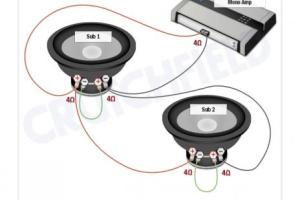Mastering Subwoofer Bridging: A Complete Guide for Home and Car Stereo Systems

-
Quick Links:
- Introduction
- Understanding Subwoofer Bridging
- Why Bridge Subwoofers?
- Types of Subwoofers
- Equipment You Need
- Step-by-Step Guide to Bridging Subwoofers
- Common Mistakes to Avoid
- Expert Insights
- Case Studies
- Conclusion
- FAQs
Introduction
Bridging subwoofers is a popular technique among audiophiles and casual listeners alike, allowing for enhanced sound quality and a more powerful bass experience. Whether you're setting up a robust home theater or upgrading your car audio system, understanding how to bridge subwoofers can be a game-changer. This comprehensive guide covers everything you need to know about bridging subwoofers, step-by-step instructions, common mistakes to avoid, and expert insights.
Understanding Subwoofer Bridging
Bridging subwoofers essentially means connecting two channels of an amplifier to a single subwoofer. This process allows the amplifier to deliver more power to the subwoofer, increasing its output and improving overall sound performance. Bridging is particularly useful in situations where you want to maximize the effectiveness of your sound system without adding additional equipment.
Why Bridge Subwoofers?
There are several reasons why you might consider bridging subwoofers:
- Enhanced Sound Quality: Bridging can lead to clearer and more powerful low frequencies.
- Increased Power Output: Amplifiers have more power available when bridged, driving the subwoofer more effectively.
- Space Efficiency: Instead of multiple amplifiers, you can achieve better performance with fewer components.
Types of Subwoofers
Before diving into the bridging process, it's essential to understand the types of subwoofers available:
- Passive Subwoofers: Require an external amplifier for power.
- Active Subwoofers: Have a built-in amplifier, making them easier to set up.
- Sealed Subwoofers: Provide tight and accurate bass response.
- Ported Subwoofers: Deliver louder bass at the expense of some accuracy.
Equipment You Need
To successfully bridge subwoofers, you'll need the following equipment:
- Amplifier with bridging capability
- Subwoofer(s)
- Speaker wire (12-16 gauge recommended)
- Wire strippers
- Screwdriver
- Multimeter (optional for testing)
Step-by-Step Guide to Bridging Subwoofers
Follow these steps to bridge your subwoofers effectively:
Step 1: Check Your Equipment
Before starting, ensure that your amplifier supports bridging. Check the manual for specifications regarding bridging and power output.
Step 2: Prepare the Wiring
Using wire strippers, prepare your speaker wires by stripping the ends to expose copper. You will need two lengths of wire for each subwoofer.
Step 3: Connect the Subwoofer
Connect the positive terminal of the first channel of the amplifier to the positive terminal of the subwoofer. Then connect the negative terminal of the second channel of the amplifier to the negative terminal of the subwoofer. This configuration is essential for proper bridging.
Step 4: Secure Connections
Ensure that all connections are tight and secure. Loose connections can lead to sound quality issues and potential damage.
Step 5: Test the System
Turn on the amplifier and play some music. Gradually increase the volume to test the sound output. Listen for clarity and bass response to ensure proper bridging.
Common Mistakes to Avoid
Here are some common pitfalls to avoid when bridging subwoofers:
- Connecting the subwoofer incorrectly, which can damage the amplifier.
- Using inadequate wire gauge, leading to power loss.
- Not securing the connections properly, causing sound issues.
Expert Insights
Industry experts recommend considering the following:
- Always match the impedance of your subwoofer to the amplifier's specifications.
- Invest in quality speaker wire to ensure optimal performance.
Case Studies
Let's look at a couple of case studies:
Case Study 1: Home Theater Setup
Avid audiophile John decided to bridge his subwoofers for his home theater system. After following the steps outlined in this guide, he reported a significant improvement in bass response, allowing him to experience movies like never before.
Case Study 2: Car Audio Upgrade
Maria was looking to upgrade her car audio system. By bridging her subwoofers, she achieved a more profound and powerful bass, making her daily commutes more enjoyable.
Conclusion
Bridging subwoofers can significantly enhance your audio experience, whether at home or in your car. By following this comprehensive guide, you can improve sound quality and enjoy a richer bass response.
FAQs
1. What does it mean to bridge a subwoofer?
Bridging a subwoofer involves connecting two channels of an amplifier to a single subwoofer to increase power output and improve sound quality.
2. Can I bridge any amplifier?
No, not all amplifiers support bridging. Always check the amplifier's manual for specifications.
3. Do I need special cables to bridge subwoofers?
You should use high-quality speaker wire (12-16 gauge) for optimal performance.
4. What happens if I bridge incorrectly?
Incorrect bridging can cause damage to your amplifier or subwoofer, resulting in poor sound quality or a complete failure of the equipment.
5. How can I tell if my subwoofer is bridged correctly?
Listen for clarity and powerful bass response. If the sound is distorted or weak, you may need to check your connections.
6. Can I bridge multiple subwoofers?
Yes, you can bridge multiple subwoofers, but ensure the amplifier can handle the combined impedance.
7. What is the best subwoofer for bridging?
Any subwoofer with appropriate impedance ratings that match your amplifier can work well for bridging.
8. Is bridging subwoofers worth it?
Yes, bridging can enhance the audio experience, providing better sound quality and more powerful bass.
9. Do I need a professional to bridge my subwoofers?
While it's possible to do it yourself, consulting a professional can ensure optimal setup and avoid mistakes.
10. What are the signs of a bridged subwoofer malfunction?
Signs include distorted sound, overheating, or the amplifier going into protection mode.
By following this guide, you'll be well-equipped to bridge subwoofers effectively, whether for your home or car audio systems. Enjoy the enhanced sound quality and powerful bass that comes with a well-bridged setup!